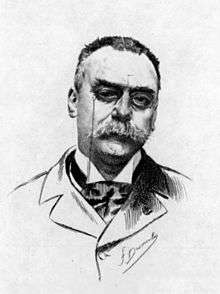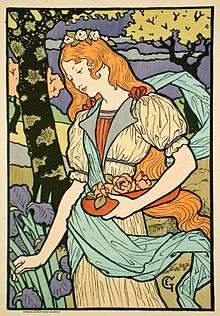Eugène Grasset
| Eugène Grasset | |
|---|---|
 Eugène Grasset, from Joseph Uzanne, Album Mariani, vol III; Paris: Floury, 1897 | |
| Born |
25 May 1845 Lausanne, Switzerland |
| Died |
23 October 1917 (aged 72) Sceaux, Hauts-de-Seine, France |
| Style | Art nouveau |

Eugène Samuel Grasset (25 May 1845 – 23 October 1917) was a Franco-Swiss decorative artist who worked in Paris, France in a variety of creative design fields during the Belle Époque. He is considered a pioneer in Art Nouveau design.
Biography
Grasset was born in Lausanne, Switzerland, his birth year is sometimes stated as 1841. He was raised in an artistic environment as the son of a cabinet designer/maker and sculptor. He studied drawing under Francois-Louis David Bocion (1828–1890) and in 1861 went to Zurich to study architecture. After completing his education, he visited Egypt, an experience that would later be reflected in a number of his poster designs. He became an admirer of Japanese art, which influenced some of his designs. Between 1869 and 1870, Grasset worked as a painter and sculptor in Lausanne. He moved to Paris in 1871 where he designed furniture, fabrics and tapestries as well as ceramics and jewelry. His fine art decorative pieces were crafted from ivory, gold and other precious materials in unique combinations and his creations are considered a cornerstone of Art Nouveau motifs and patterns.
In 1877 Eugène Grasset turned to graphic design, producing income-generating products such as postcards and eventually postage stamps for both France and Switzerland. However, it was poster art that quickly became his forte. Some of his works became part of the Maîtres de l'Affiche including his lithograph, "Jeanne d'Arc Sarah Bernhardt." In 1890, he designed the "Semeuse who spreads seeds of dandelion" logo used by the dictionary publishers, Éditions Larousse.
With the growing popularity of French posters in the United States, Grasset was soon contacted by several American companies. In the 1880s, he did his first American commission and more success led to his cover design for the 1892 Christmas issue of Harper's Magazine. In 1894 Grasset created "The Wooly Horse" and "The Sun of Austerlitz" for The Century Magazine to help advertise their serialized story on the life of Napoleon Bonaparte. The "Wooly Horse" image proved so popular that Louis Comfort Tiffany recreated it in stained glass. Grasset's work for U.S. institutions helped pave the way for Art Nouveau to dominate American art.
Grasset taught design at the École Guérin from 1890 to 1903, at the École d’Art graphique in the rue Madame from 1903 to 1904, at the Académie de la Grande Chaumière from 1904 to 1913 and at the École Estienne in Paris. Among his students were Paul Berthon, Georges Bourgeot, Paul Follow, Marcelle Gaudin, Augusto Giacometti, Arsène Herbinier, Anna Martin, Mathurin Méheut, Juliette Milési, Otto Ernst Schmidt, Auguste Silice, Maurice Pillard Verneuil, Aline Poitevin, Pierre Selmersheim, Tony Selmersheim, Camille Gabriel Schlumberger, Eliseu Visconti, and Philippe Wolfers
At the Universal Exhibition of 1900 in Paris, the G. Peignot et Fils typefoundry, introduced the "Grasset" typeface, an Italic design Eugène Grasset created in 1898 for use on some of his posters.
Eugène Grasset died in 1917 in Sceaux in the Hauts-de-Seine département, southwest of Paris.
Exhibitions
- Cantonal Museum of Fine Arts, Lausanne, 2011.
See also
- Poster
- Georges Peignot, who made Grasset working for his typefoundry
| Wikimedia Commons has media related to Eugène Grasset. |
External links
- Publications by and about Eugène Grasset in the catalogue Helveticat of the Swiss National Library